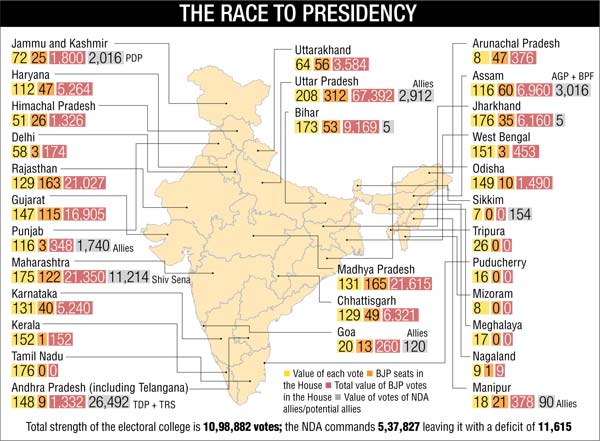
The forthcoming Presidential election will be a test for India’s fragmented Opposition to show some spine against the NDA alliance, which has seen a resurgence under Prime Minister Narendra Modi.
NDA’s chances of electing the 14th President of India have only risen after the BJP and its allies won 325 seats in UP, 57 in Uttarakhand, and an impressive 21 in Manipur. However, a major roadblock to those chances is the fact that it still commands just 48.10 per cent support in the electoral college. A united Opposition, on the other hand, has 51.90 per cent support in the electoral college comprising elected members of Lok Sabha, Rajya Sabha, and members of all Legislative Assemblies.
Each vote is weighted in accordance with proportional representation. While all MP votes carry equal value, the weightage of MLA votes differs from state to state. MLAs from Uttar Pradesh carry the highest value while those from Sikkim have the least. But PM Modi and BJP president Amit Shah can draw solace from the fact that they can expect the AIADMK, TRS, Andhra Pradesh’s YSR Congress to back its candidate to bridge the gap. They were earlier banking on the BJD as well. But with the BJP emerging as the principal Opposition party in Odisha politics with impressive gains in the panchayat elections in the state recently, that bridge has burnt for now. A rattled chief minister Naveen Patnaik has now shifted focus from opposing Congress to keeping the BJP in check now. Maths apart, the upcoming July 2017 presidential election will go down to the wire and could be a repeat of the last closely contested election in 1969, when VV Giri trounced the Congress party’s official candidate Neelam Sanjeeva Reddy by a slim margin. The total strength of the electoral college is 10,98,882 votes. The halfway mark is 5,49,442 votes. But in the fifth presidential election, no candidate reached the required majority mark in the first count. Candidate after candidate was ousted until only Giri and Reddy remained in the fray. Finally, Giri emerged victorious.
Congress President Sonia Gandhi, with the help of Bengal archrivals- the Left and the Trinamul Congress (TMC)- and JD (U), is trying to unite the Opposition to field a common candidate to take on the BJP juggernaut. She has held meetings with NCP leader Sharad Pawar, JD(U)’s Sharad Yadav, Lalu Prasad Yadav (RJD), Sitaram Yechury (CPI-M), and Nitish Kumar (RJD). Mamata Banerjee (TMC) too has called for the Opposition to unite in putting up a strong consensus candidate. There are 776 voting MPs of the Lok Sabha and Rajya Sabha together, and 4,114 voting MLAs across all legislative assemblies. Since states vary in size and population, the value of each MLA vote is calculated by taking the total population of the state and dividing it by the number of MLAs of that state multiplied by 1000. As per this formula, each state is given proportionate weightage based on size and population of that state, which is why winning the UP elections with a clear majority was so crucial for the BJP.

NDA’s prospect for electing its own candidate as the 14th President are on a razor edge with just 48.10 per cent support of the electoral college
Had the UP elections thrown up adverse results, its chances of sailing through in the presidential elections would have been slim. Losing power in many states since 2012 has made Congress’ position weaker. Congress-led UPA, which now consists of just five parties, has a mere 15.90 per cent support in the electoral college. The regional parties command support of 23.80 per cent. Besides these, the AIDMK, TRS, BJD and independents share 12.20 per cent votes in the electoral college. During the 2002 elections, when the NDA, under Atal Bihari Vajpayee, was also struggling with numbers, it put up APJ Kalam as its choice of candidate. The Left Front put up Lakshmi Sahgal as their candidate at the last minute. But other Opposition groups, like BSP, AIADMK, and even Congress extended support to APJ Kalam. In 2007, when UPA put up Pratibha Patil as their candidate of choice, Shiv Sena broke from the NDA and came in support of a fellow Maharashtrian and voted for Patil. This time again, the challenge for the PM and Amit Shah is to put out a candidate who will keep alliance partners close together and also lure a few other groups from the Opposition. One thing is for sure. The election will generate considerate heat in the coming days and, in the run up to the 2019 general elections, will also test the Opposition’s unity.
The author is Editor (Strategic Affairs), DNA